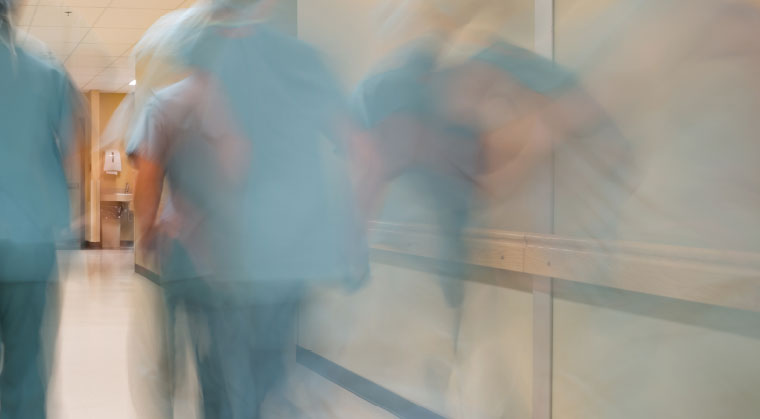Class Action

I almost fainted at this blatant anti-Semitism. I quickly ran through appropriate responses in my head, and rejected them all. It would be a waste of breath to even respond

I
t was Friday afternoon. I was packing up my books and papers, handing out final assignments to my students, and calculating how long it would take me to get home to put up the chicken soup before Shabbos.
A student approached my desk. Mohammed was a tall boy, originally from Saudi Arabia, and making excellent progress in learning English. He slipped me a book and recommended I read it over the weekend. I glimpsed at the title: Introduction to Islam 101. Glancing at Mohammed, I saw that his expression was serious, and that he had a definite agenda. He wants to convert me!
I taught in a multicultural school in downtown Toronto. If I didn’t say the politically correct statement, I could get into serious trouble — even get fired. I did the only thing I could think of: I sprinted to the principal’s office and blurted out, “Mr. Buhler, please handle this.”
“I trust you can handle this yourself,” the principal calmly replied. “You must simply tell your student that the Toronto District School Board is nonsectarian, and one isn’t allowed to proselytize on school premises.”
I spent an uneasy Shabbos with my unwanted acquisition, and on Monday morning, I found Mohammed and gently explained that it was very kind of him to lend me the book. However, distributing the book was against school regulations. He didn’t know much English, but he got the message. At least no more books about Islam were passed in my direction.
I spent 19 years as a guidance counselor and English teacher for immigrants to Canada, mostly from Southeast Asia, but also from South America, Eastern Europe, and many Muslim countries. It would have been easier and more comfortable to teach in a Jewish school, but there were no vacancies at the time. When I was offered a job in the public school system, I took on the challenge.
While I was there, I learned so much about what it means to be an ambassador for the Jewish People. After all, I was probably the first Orthodox Jew these people had ever encountered. I learned to measure every word, to keep tight rein on how I acted and interacted — and to have a good laugh along the way. It was fascinating to meet people from so many countries: Brazil and Argentina, Ethiopia and Nigeria, Poland, and Romania… not to mention the influx of Muslim students from Saudi Arabia, Syria, Iraq, Iran, Turkey, and Lebanon.
In short, it was an adventure. At least, most of the time.
First, there were my colleagues. The head of the department was from Poland, and one day, she happened to mention that her grandparents were originally from Germany and had been reform Jews. Because of perceived better job opportunities, they converted to Christianity in Poland. They owned a bakery that produced all kinds of delicacies. When the Germans invaded, they took over the bakery, and forced her grandparents to bake bread for the German army.
Their daughter — my colleague’s mother — looked Jewish, so she spent all day hiding under the wooden floor of the bakery. “When I’d visit her grandmother in Poland, long after the war, she’d close the shutters and lock the doors,” my colleague told me. “All those years later, she was terrified I’d be snatched away by the Nazis.”
The vice-president of the school also had a Jewish connection. Her father was a survivor of Auschwitz, and although he moved to Argentina after the war and married a non-Jewish woman, my colleague considered herself Jewish. She’d sometimes meander into the classroom when I was teaching and beginning reminiscing, telling over stories her father had told her about the Warsaw ghetto and Auschwitz.
A brilliant Jamaican co-teacher used to refer to me as one of the Chosen People. She was fascinated by Judaism, and sends me a Rosh Hashanah and a Pesach card every year.
But not all professional interactions were smooth. The Friday after 9/11, I had an encounter with the English Literature teacher, Mr. James, who had spearheaded a drive to send books to children in Honduras. I told him that I admired his volunteer project, and in response, he blurted out: “It’s the fault of Israel and the Jews that the World Trade Center collapsed.”
I almost fainted at this blatant anti-Semitism. I quickly ran through appropriate responses in my head, and rejected them all. It would be a waste of breath to even respond. Instead, I went to the principal and reported his comment. The principal was in a meeting at the time, but the office manager assured me that she’d take care of it. I didn’t hear from her the rest of the afternoon.
At 3:15, I was about to zoom home to make last-minute preparations for Shabbos. As I was packing my bag, I received a message that I was wanted immediately in the principal’s office. My heart sank. I reluctantly went to the office, davening that this would only take two minutes. Mr. James stood there. The principal looked at him, then at me, and explained that Mr. James had made a hurtful, racist comment. She expected him to apologize immediately.
Mr. James’ face turned bullish. “I am never going to apologize.”
“You certainly will,” said the principal. “I don’t care if we have to stay here all night, but you will apologize for the comment.”
Stay here all night? I had to get home in time for Shabbos!
The principal launched into a long lecture about the civil war in Ireland, and the longstanding friction there between Protestants and Catholics. I nodded along, but all I could think of was my chicken soup and the clicking clock. It took an agonizing forty-five minutes, but ultimately, Mr. James very reluctantly apologized… and I raced out of the building.
It was sobering to realize how anti-Semitism is so deeply rooted in seemingly intelligent, rational, and even charitable people. Although I attempted to be on good terms with my colleagues, I always kept up my guard.
Nevertheless, there were times when I had no choice but to explain myself. Like the time I received a note to see the office manager right away. It was a Monday morning, and I assumed I had to sign a permission slip for an upcoming Yom Tov. To my surprise, the office manager said, “My daughter and I were driving down Bathurst Street (the main Jewish thoroughfare in an Orthodox neighborhood in Toronto) on Saturday and it was pouring.
“We saw lots of women with elegant coats and high-heeled shoes — but not a single umbrella. My daughter said she thinks it has something to do with the Jewish religion.” The office manager shook her head. “How in the world can an umbrella have a connection to a religion? That’s crazy.”
I thought for a moment, then casually replied, “Actually, umbrellas have everything to do with our religion,” Then I explained, “Over two thousand years ago King Solomon built a Temple in Jerusalem. All of the 39 ways to build this Temple are prohibited on the Sabbath. One way of building was constructing a new edifice. The rabbis taught us that opening an umbrella is also constructing something new. Therefore, we don’t use umbrellas on Shabbos.” Then I complimented her daughter: “She must be an exceptionally clever girl!”
***
I never advertised my Jewishness, but one year, I had a class of mostly Chinese students. I explained to them that I’d be taking off the next two days because of Shavuos, and they’d be taught by an excellent substitute. A bright Chinese student called out, “Ms. Ginz, I also want to be Jewish. You have so many holidays!”
Think quick: how will I reply quickly and convincingly? “If you’re Jewish, you can’t eat at McDonalds,” I stated simply. “Jews aren’t allowed to eat cheeseburgers.”
“What in the world do cheeseburgers have to do with religion?” he asked.
I replied that we eat special kosher food and we can’t eat dairy and meat products together. He thought for a long moment. “Hmm, I guess I don’t want to be Jewish after all.”
One semester, in September, I entered the classroom to the sound of chairs being scraped back. All my students were standing in respect. I blinked, and looked around at the faces. Ah! Here was the answer. Most of my students that semester were from China, Hong Kong, and Taiwan. They were simply showing me the respect they accorded their teachers back home. It felt so good — in fact, it was almost like I was a limudei kodesh teacher, about to teach Chumash.
However, in the back of the classroom was a student from Lebanon. His clothing was disheveled, and he sat with stooped shoulders. When he looked up, there was something in those eyes that made me shiver.
Rosh Hashanah was soon approaching, and I grew worried. If he realized I was taking time off from teaching for Rosh Hashanah — realized I was Jewish — I was afraid he’d target me.
I turned to the guidance office for advice. The counselor was incredulous that I hadn’t been told the background of this particular student. “No one told you about Hassan? His father is in jail for terrorism.”
If I’d been worried before, I was then frantic. There was nothing for me to do but daven. Hashem answered my tefillos in a unique way. The week of Rosh Hashanah came. Monday morning and Hassan was not in class. He didn’t turn up on Tuesday or Wednesday. I retraced my steps to the guidance counselor. “What happened to Hassan?” I inquired.
“Ah. Hassan.” She looked up at me. “Hassan decided there’s no point in gaining his high-school diploma if he can earn fast cash selling drugs on the street.”
I returned to the classroom, breathing a sigh of relief.
That wasn’t my only experience with potential terrorists in my classroom.
It was just after 9/11, and we were all walking around in a state of shock. I was administering a test, and there was one boy, a Muslim from Pakistan, who wasn’t writing the test because he evidently hadn’t studied. “You can draw a picture on the other side of the paper,” I casually recommended to Mohammed.
When I collected the papers, I noticed what he’d drawn. It was a picture of an airplane ramming into the CN Tower, the highest skyscraper in Toronto. Shocked, I took the drawing to the vice-principal, and asked him to pass the picture on to the police. He looked at the picture and didn’t bat an eyelid.
I started to question myself: maybe this was nothing. Just the wild scribbling of a child influenced by recent events. But I held firm, and reassured myself that whatever the picture did or didn’t mean, I had to do my duty. I later found out that the police made some arrests, and there were people who had planned to blow it up. It wasn’t just my imagination after all.
***
I often had to walk a tightrope. While I had to be careful of the people around me, some of whom were genuinely threatening, I also had to show them the utmost respect. And my words had to be entirely politically correct. It becomes a consciousness: you’re aware of everything that comes out of your mouth, and how it will be perceived by others. If there was ever proof that we can observe the laws of shemiras halashon, this was it.
Nevertheless, there were times when I slipped up. When the infamous Hamas terrorist Ahmed Yassin was successfully eliminated by the Israeli Air Force in Gaza. I came into class and, in Hebrew, joyously conveyed the news to my one Jewish student. Originally from Russia, Vadim had lived in Israel for six six years before coming to Canada. I was telling Vadim the news when in walked Ali Mansour — a Muslim student from Syria.
He couldn’t have understood my Hebrew, but he must have just heard the same news in Arabic, and he exploded, “You Jews are a bunch of murderers! You killed a blind man in a wheelchair! Every day you kill women and children in the West Bank. You’ve stolen our land and now you have killed our imam.”
What to do now?
If I called the administration and asked them to defuse the situation, I’d probably get suspended for even mentioning the topic. I took a deep breath, and quietly said, “Ali, most of the students here are from China. They don’t understand these political issues. How about you educate them? First you present the view from the Arab world, and then Vadim or I will present the Israeli viewpoint. This will be a wonderful opportunity to broaden the horizons of the other students.”
Luckily, Ali took up my invitation. He started screaming about the Infidels in Israel. Most of the students, mainly from Southeast Asia, didn’t have a clue what he was talking about, but I told him that he’d made many interesting points. Then I drew a map of the Middle East and gave the class a brief history lesson of Israel, from 1947 until today. The students listened politely, still not following much of what I was saying.
I thanked Ali again and began my regular lesson. When I finished, I heard Vadim and Ali whispering to each other. I leaned forward to listen — were they going to continue the debate? Would there be more accusations? But I breathed a sigh of relief — they were simply discussing the best place in town to get a pita and falafel.
There was a time I almost lost my job for so-called racism. A Jewish philanthropist from Peru had sponsored inner-city kids to learn musical instruments and form an orchestra. The orchestra was coming to our school to perform. I was informed that the Muslim students from Saudi Arabia would not be attending — they had a prohibition against listening to Western music. I was infuriated, and went to the vice-principal who was sitting in the auditorium.
“This is not right,” I told her, barely registering the woman sitting next to her, wearing a power suit and an identity necklace. “The children came here to get a public education, and they have to learn to honor other cultures. That’s part of the reason they’re here.”
I said my bit, the vice-principal nodded and dismissed me. That afternoon, I was summoned to the office. “You almost lost your job today,” she told me. “The superintendent of the school system was sitting beside me, and she thought you were being racist. It took a lot of persuading to convince her that you show respect to every culture, and not have you fired on the spot.”
***
I was certainly kept on my toes, and every day brought another surprise. One blustery day in December, 2009, our department took the students to an ice skating rink on the edge of Lake Ontario. All the students came from Third World countries, and most had never skated. The teachers who accompanied them also reflected the multicultural milieu of Toronto: one teacher came from Poland, another from Jamaica, one was from Canada, and then there was yours truly. The trip went beautifully, and towards the end, I was approached by a group of students from Saudi Arabia. “There’s no mosque here, so where’s the closest place to pray, Mrs. Ginz?”
I blinked.
It was time for them to say their afternoon prayers, and they wanted me to find them an appropriate place. Here I was, an Orthodox woman, searching for a place for Muslims to pray. I noticed an art gallery that looked quiet, so I went in and hesitantly made my request, “Could five students please say their afternoon prayers in your art gallery?” The manager was a kind and liberal Torontonian, and was happy to accommodate the unusual request.
I collected my Saudi Arabian students and led them inside. But there was another problem: the girls told me they needed a mechitzah…. Were they ever religious! Finally, a compromise was reached: the girls would pray behind the boys. Hashem, I don’t believe this is happening to me! I thought.
Definitely the most interesting experience was at the end of the semester. I’d been teaching girls from Saudi Arabia who wore the full niqab. Only their eyes peeked through, and I had no idea what they looked like. For an entire semester. At the end of the semester I mustered up some courage and asked Manar, “Could I please see your face?” She said she’d return after lunch, we’d lock the classroom door, and then she’d show me her face. I was relieved and excited when she appeared. She gently took off her veil and I saw a beautiful teenager. Then she asked me if I’d like to see her hair. “Certainly,” I replied. She took off her hijab to reveal long, curly, black hair.
“Would you like to see what is below my long black gown?” she asked.
“Certainly.”
She took off her black, flowing gown, and lo and behold, what did I see? A typical teenager wearing a Gap T-shirt, Levi jeans, and Adidas sneakers!
There were other experiences that were more than surreal. Like the time the Jewish community center put on an exhibition of Czech Jews in World War II. The head of the department insisted I take the kids to see it. So in we trouped, a group of kids from all over the world, including two girls from Pakistan wearing hijabs. It was a powerful and moving exhibition, with pictures accompanied by placards that told the stories of the murdered Jews. So many of them had had beautiful childhoods.
We assigned each pair of students one story, which they had to tell over to the rest of the group. The kids were moved — and the two hijab-clad girls cried as they told over the biographies. The incongruity struck me. And that’s also when I realized that it’s easier to deal with children than adults.
With my colleagues, I had no idea how much animosity simmered under the surface. The children were more straightforward and understood the tragic circumstances of these Jewish people’s lives. Thankfully, they could be moved by simply appealing to their humanity. And that’s what I tried to do.
Once, I assigned an essay to a group of adult students and one student wrote about “Breaking Stereotypes.” I knew I’d achieved something when I read the following:
“Following the revolution in Iran, for many economic reasons and especially due to war with Iraq, my family decided to leave the country. We resided in the UAE for three years before moving to Canada. My whole life I had been educated to hate all Jews, but I had never met a Jew before. I had my first close personal contact with Jewish people in Canada… my physician in Montreal was Jewish, my immigration lawyer in Montreal was Jewish, and then when I moved to Toronto, my English teacher was Jewish as well….
“Mrs. Ginz was a supportive teacher, a caring friend, a loving personality, and a Jewish lady who provided me with all the care, support, and flexibility I needed to continue her program. I believe that most stereotypes are the result of political and historical matters. Every individual is different and any kind of character can be found in any society. There is no hard and fast rule of humankind…. Now, having gone through this experience of knowing the Jewish culture, I am most reluctant to accept any kind of such stereotypes.”
I survived in the job for 19 years, until we were fortunate enough to be able to return to Eretz Yisrael. Certainly, life is more pleasant now. However, I’m proud of the years I spent showing people that a Jew is a person of integrity. I knew that every action could make a kiddush Hashem or a chillul Hashem, and my personal mandate was to be a worthy ambassador of my people. Today, some of the people whom I taught or guided are still in touch with me. And though most aren’t, I hope they’ll remember a Jew who went out of her way to show them respect and care.
(Originally featured in Family First, Issue 588)
Oops! We could not locate your form.












